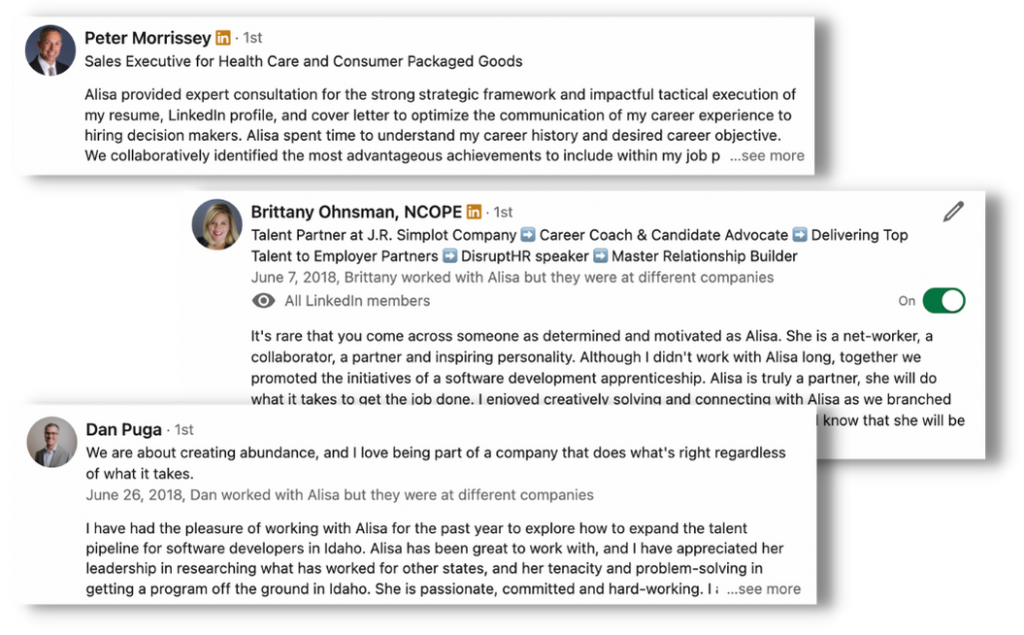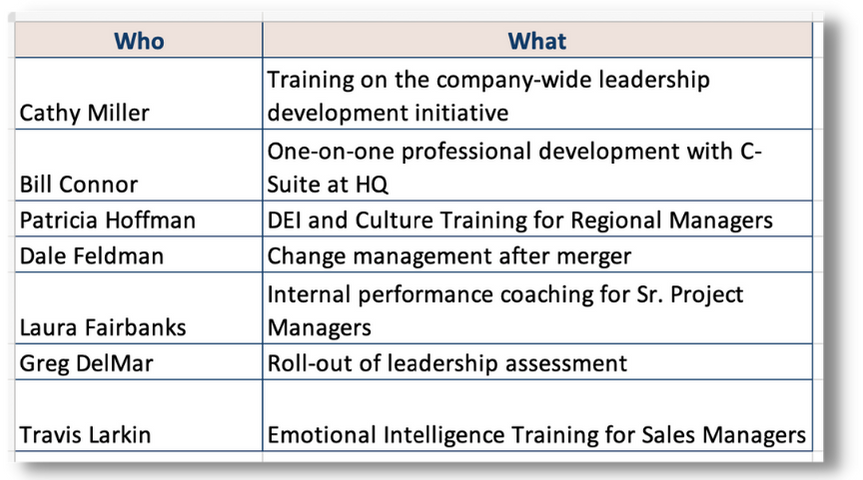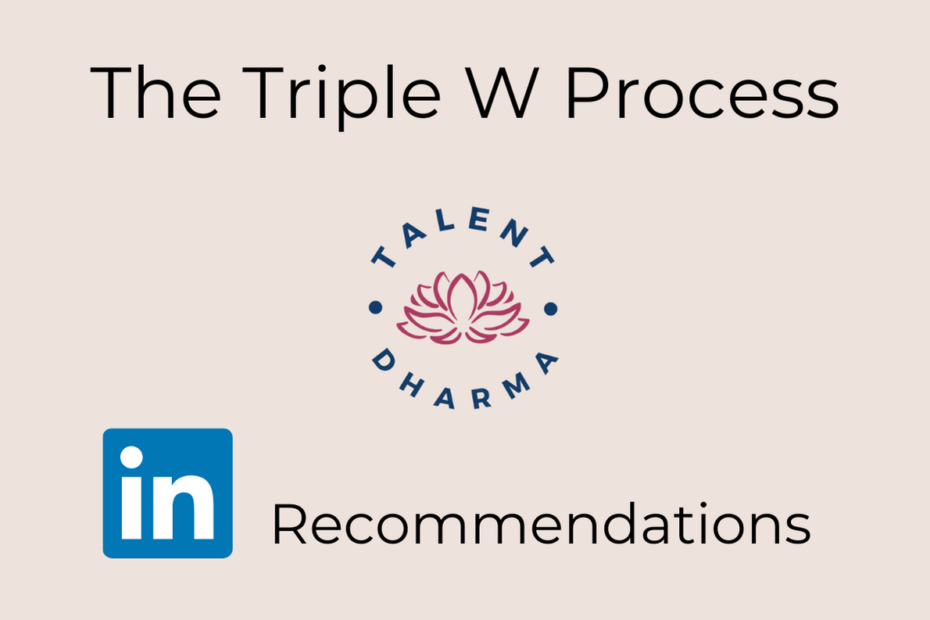Remember that saying “words are empty without actions to back them up?” I think about this statement when anyone asks me how important recommendations are on their Linkedin profile. While the words you choose to place in your profile are purposeful, especially for SEO, backing them up with action can give their meaning an added boost. In this case, in the form of recommendations. Securing and adding recommendations on your LinkedIn account transforms your words into evidence of your achievements. A well-written recommendation is one of the best ways to reinforce your claims of competency and experience. This social proof, in the form of recommendations, makes you more trustworthy. What’s social proof, you ask? Social proof is a form of currency that communicates to others that you can be trusted and are an expert in what you do. And, according to LinkedIn, recommendations offer you that all-important social proof that your profile just might be missing.
With 95% of recruiters scouring LinkedIn users to find the right candidate, LinkedIn recommendations are a critical addition to your profile that should not be overlooked. Your recommendations are professional references/testimonials that give recruiters, employers, and prospects the opportunity to see how you have shown up in your current or previous positions.
Asking for a recommendation may bring up some angst. Individuals may be uncomfortable singing their own praise. Others might fear rejection. And many, just don’t know where to start. But I’ve got you covered. In this week’s post, I’ve created an easy-to-follow, Who What Why (The Triple W), process on obtaining LinkedIn recommendations. Let’s get started.
THE TRIPLE W PROCESS
- Who?
The first step is identifying who you want to secure recommendations from and placing the names in a spreadsheet. Think about anyone who can attest to your performance in your current or past jobs. Reach beyond your current or past direct supervisors by identifying individuals who were your colleagues, direct reports, clients, leadership team members, or partners. After you’ve identified your “recommenders”, search for each of them on LinkedIn. If they are not a first connection, send them an invitation to connect with a customized note. Pro Tip: Worried that you’ve missed someone important? No problem. LinkedIn gives you the ability to view all your first-degree connections in one fell swoop. Go to your Settings & Privacy to get a download of your connections.

What?
Next up is getting specific about the what. Go back to the spreadsheet you created and, in the column, adjacent to the names, write down what you want a recommendation on. When making an ask, it is important that you give your recommenders context. Share what skill, experience, traits, or project you would like a recommendation for. The spreadsheet will look something like this:

For me, seeing examples are always extremely helpful. So, just in case you’re like me, here’s how the customized messages might look:
Hi Cameron, I hope you’re having a great week! I want to let you know how much I enjoy working with you, as well as how much I value your insights and feedback. I’ve especially enjoyed collaborating with you on the company-wide leadership development initiative. I have a small request for you. I’d love it if you could write me a LinkedIn recommendation that highlights my skills in organizational development and training.
And for the career transitioner:
Hi Cameron, I hope everything’s going great in Oregon! It was great seeing you at the Chamber event before you left. I’m writing to ask if you’d be willing to write a LinkedIn recommendation for me that highlights my organizational development and training skills. Ideally, I’d love for you to outline the experience you had with me through the company-wide leadership development initiative last year.
Why?
Last, but certainly not least, we have the why. Let your connections know why you are requesting a recommendation at this time. This is especially important if you are currently working and are concerned your connection might conclude that you are seeking to leave your current position. Which may or may not be the case. See the examples below of how I added in the why.
Hi Cameron, I hope you’re having a great week! I want to let you know how much I enjoy working with you, as well as how much I value your insights and feedback. I’ve especially enjoyed collaborating with you on the company-wide leadership development initiative.
I have a small request for you. I aim to keep my LinkedIn profile updated to provide an accurate picture of my skills and experiences for my clients and partners. With that in mind, I’d love it if you could write me a LinkedIn recommendation that highlights my skills in organizational development and training.
And for the career transitioner:
Hi Cameron, I hope everything’s going great in Oregon! It was great seeing you at the Chamber event before you left. I’m working hard to transition into a senior leadership and development role, and most of the employers I’m considering put a strong focus on organizational development and training. Would you be willing to write a LinkedIn recommendation for me that highlights my organizational development and training skills? Ideally, I’d love for you to outline the experience you had with me through the company-wide leadership development initiative last year.
The Finishing Touch
Conclude your ask with a friendly ending and an offer to write a recommendation for them in return. Pro Tip: To show your appreciation, you can offer to draft up a recommendation for them to edit themselves. Here’s how that part of the message might look:
I’d be happy to write you a recommendation in return. Just let me know if there’s something specific you’d like me to call attention to. And, if this feels too time-consuming, I am more than happy to draft up a recommendation and send it over to you. Then, you can edit however you see fit. Let me know what you think!
All my best,
Laura McLaughin
Refer to The Triple W process whenever you need to ask for a recommendation. Keeping your LinkedIn profile updated is important so use this tool whether you are currently working or transitioning between careers. If you have recently left a job, start securing your recommendations now, as time goes by it can get harder to make requests.
